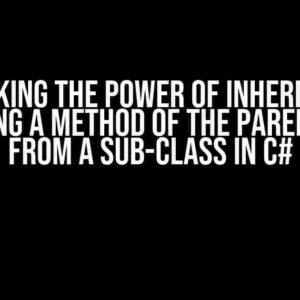As a developer, you’ve probably encountered situations where you need to dynamically control the visibility or enablement of certain components based on user input or system states. This might be a slider that reveals more options as the user increases a value, or a form that only becomes accessible when a certain threshold is met. In this article, we’ll delve into the world of dynamic components and explore how to enable or disable them according to increment or decrement values.
Understanding Dynamic Components
Dynamic components are elements that can change their behavior or appearance based on external factors, such as user input, system states, or data received from an API. These components can be anything from buttons and forms to charts and graphs. By making them dynamic, you can create more interactive and intuitive user experiences that adapt to the user’s needs.
The Importance of Conditional Logic
Conditional logic is the backbone of dynamic components. It allows you to write code that evaluates certain conditions and performs actions based on the outcome. In the context of enabling or disabling components, conditional logic is used to determine whether a component should be visible, enabled, or accessible based on the current value of a variable or input.
To illustrate this, let’s consider a simple example. Imagine you have a slider that controls the size of a font. As the user increases the slider value, the font size increases accordingly. However, you only want to display the “Large Font” option if the slider value is greater than 50. To achieve this, you can use conditional logic to evaluate the slider value and show or hide the “Large Font” option accordingly.
<if sliderValue > 50> <div>Large Font</div> </if>
Enabling or Disabling Components using Increment or Decrement Values
Now that we’ve covered the basics of dynamic components and conditional logic, let’s dive into the meat of the article: enabling or disabling components based on increment or decrement values.
### Using JavaScript
One way to achieve this is by using JavaScript to dynamically update the component’s state based on the current value. Here’s an example using a simple HTML button and a JavaScript function:
“`
```
In this example, the `incrementedCount()` and `decrementedCount()` functions are called whenever the user increments or decrements the `count` variable. The functions then evaluate the current value of `count` and enable or disable the button accordingly.
### Using CSS
Another approach is to use CSS to style the component based on the current value. This method is particularly useful when you want to hide or show components without affecting their underlying functionality.
Here's an example using a CSS class to hide or show a div:
```
```
In this example, the CSS class `hidden` is used to style the div as hidden when the count is less than 5. When the count reaches 5 or more, the class is removed, and the div becomes visible.
Real-World Scenarios
Now that we've covered the basics of enabling or disabling components based on increment or decrement values, let's explore some real-world scenarios where this technique can be applied.
### Example 1: Dynamic Form Fields
Imagine you have a form that allows users to select the number of attendees for an event. Based on the selected number, you want to dynamically show or hide additional form fields for each attendee.
| Number of Attendees: | |
### Example 2: Conditional Navigation
Suppose you have a navigation menu that should only be accessible when the user has completed a certain task or reached a specific level.
Conclusion
Enabling or disabling components based on increment or decrement values is a powerful technique that can greatly enhance the user experience. By using conditional logic and dynamic component manipulation, you can create interactive and adaptive interfaces that respond to user input and system states.
Remember to choose the approach that best suits your specific use case, whether it's using JavaScript to dynamically update component states or CSS to style components based on current values. With practice and creativity, you can unlock the full potential of dynamic components and create engaging experiences that users will love.
Frequently Asked Questions
-
Q: How do I handle multiple conditional statements?
A: Use a nested if-else statement or a switch-case statement to evaluate multiple conditions.
-
Q: Can I use this technique with other programming languages?
A: Yes, the concept of conditional logic and dynamic component manipulation can be applied to other programming languages, such as Python, Java, or Ruby.
-
Q: How do I optimize the performance of dynamic components?
A: Optimize performance by using efficient algorithms, caching, and minimizing DOM manipulation.
Further Reading
By mastering the art of enabling or disabling components based on increment or decrement values, you'll be well on your way to creating sophisticated and engaging user experiences that leave a lasting impression.
Frequently Asked Questions
Get answers to your burning questions about enabling or disabling components based on incrementing or decrementing values!
How do I enable a component when the value increments?
To enable a component when the value increments, simply use an "if" statement to check if the current value is greater than the previous value. If it is, then enable the component! For example, in JavaScript, you could use something like: `if (newValue > oldValue) { component.disabled = false; }`.
What happens if I decrement the value and the component is already enabled?
If you decrement the value and the component is already enabled, you'll want to disable the component. You can do this by using another "if" statement to check if the current value is less than the previous value. If it is, then disable the component! For example, in JavaScript, you could use something like: `if (newValue < oldValue) { component.disabled = true; }`.
How do I handle edge cases, like when the value changes from 0 to 1 or vice versa?
Edge cases can be tricky, but you can handle them by adding additional checks to your "if" statements. For example, if you want to enable the component only when the value changes from 0 to 1, you could use something like: `if (oldValue === 0 && newValue === 1) { component.disabled = false; }`. Similarly, if you want to disable the component when the value changes from 1 to 0, you could use something like: `if (oldValue === 1 && newValue === 0) { component.disabled = true; }`.
Can I use this technique with other types of values, like strings or booleans?
While the examples I provided use numeric values, you can definitely apply this technique to other types of values, like strings or booleans. Just adjust the comparison logic accordingly. For example, if you're working with strings, you could use something like: `if (newString !== oldString) { component.disabled = false; }`. If you're working with booleans, you could use something like: `if (newBool !== oldBool) { component.disabled = !newBool; }`.
What if I need to enable or disable multiple components based on the same value change?
Easy peasy! Just create an array of components and iterate over it, updating each component's enabled state based on the value change. For example, in JavaScript, you could use something like: `const components = [comp1, comp2, comp3]; components.forEach((component) => { if (newValue > oldValue) { component.disabled = false; } else { component.disabled = true; } });`.




